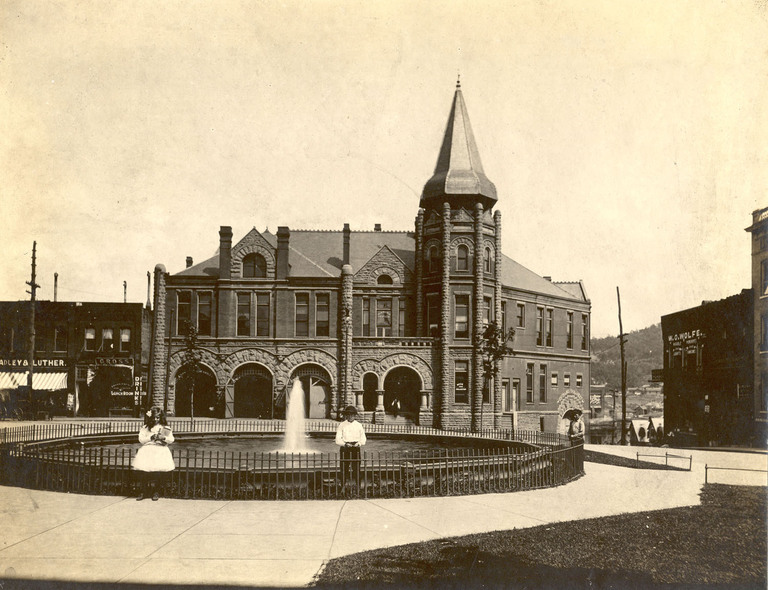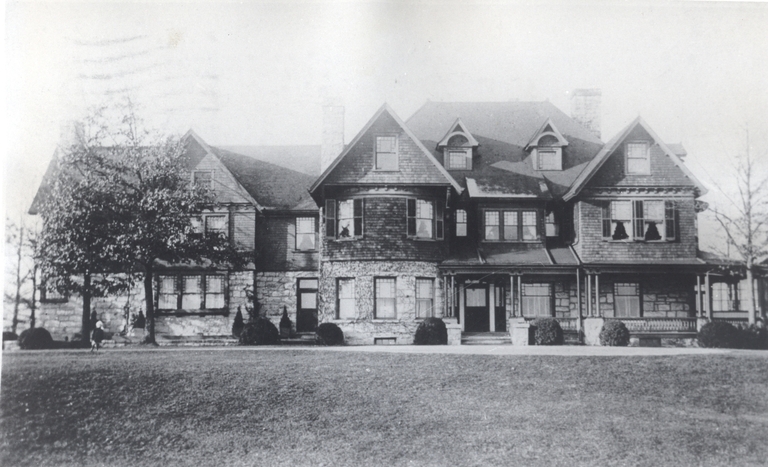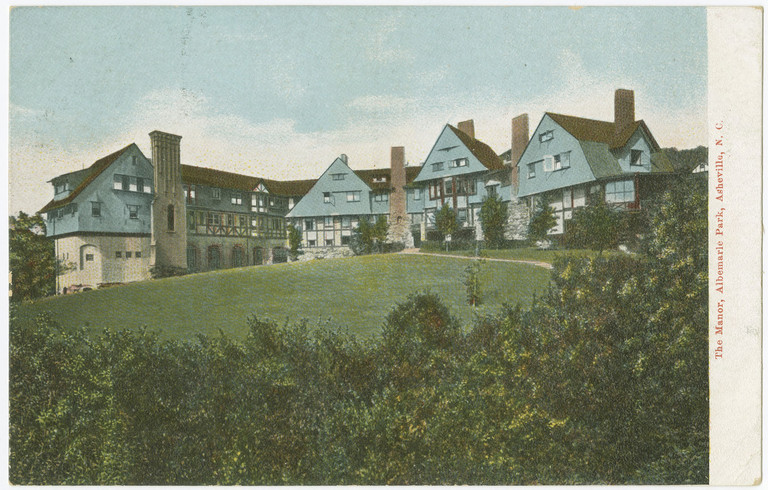Tennent, James Albert (1842-1916)
Birthplace:
Charleston, South Carolina, USA
Residences:
- Charleston, South Carolina
- Asheville, North Carolina
Trades:
- Architect
- Builder
NC Work Locations:
Building Types:
Styles & Forms:
Queen Anne; Romanesque Revival; Second Empire; Shingle Style
James Albert Tennent (1842-1916) was a builder and architect active in Asheville’s late 19th century boom years. One of many Confederate veterans who established a new life after the Civil War, he built important public buildings and houses from the 1870s onward, and continued into the early 20th century as the city’s “dean” of architects and builders.
A native of Charleston, South Carolina, James Albert Tennent was the son of William M. and Eliza (Elizabeth) Tennent, part of a prominent Charleston family. He graduated from the South Carolina Military Academy in the spring of 1861 and took a commission in the Calhoun Guards, then served through the war in the infantry and engineer corps. He also served as an instructor at the Hillsborough Military Academy in North Carolina. In 1869 in Charleston, Tennent married Elizabeth West, daughter of George Washington West and Cordelia West of Philadelphia. By 1870, Albert and Lizzie Tennent and their baby Cordelia (who died young) were living in Charleston with his elder brother William, a civil engineer, and their widowed mother, Eliza.
Along with other South Carolinians after the war, “Captain” Tennent moved to western North Carolina, arriving in Asheville in 1871 or 1872. By 1880, James Albert and Elizabeth and their infant son George were living in Asheville, with James listed as a farmer. Elizabeth’s parents were living nearby. Tennent’s sister, Ann Martha (Mrs. William Hume), also moved to Asheville.
Within a decade of Tennent’s arrival in the area, the completion of the Western North Carolina Railroad to Asheville in 1880 produced an astonishing boom in building. Tennent planned some of the city’s most important buildings, robustly eclectic structures typical of the late 19th century. Listed as a farmer in the 1880 census, Tennent was called a house contractor in 1900, and an architect in 1910.
Indicative of his early stature in Asheville, Tennent’s first major building project was the Buncombe County Courthouse of 1876. The county’s sixth courthouse, it was a massive brick building with immense mansard-roofed tower, located at the east edge of the central public square. As the city expanded, he took on many other projects, the most prominent being the Asheville City Hall of 1892, an eclectic, towered edifice just east of his courthouse.
Tennent also did extensive residential work. The Asheville Citizen reported on April 1, 1890, that he had contracts for $35,000 worth of houses, and on May 21, 1891, that he was building a 17-room residence for T. Hohagan, plus many other houses valued at $3,000 to $5,000 each. An especially conspicuous project was a residential complex called “The Manor and Cottages” at Albemarle Park in suburban Asheville, designed by architect Bradford L. Gilbert of New York. The June 14, 1898 Asheville Daily Citizen gave an extensive account of “Work in Albemarle Park: The Manor House Now Under Construction,” noting Tennent as the contractor. In 1899, the Citizen said that Tennent and A. L. Melton were building a 20-room house called the “Klondike” (Klondyke) for capitalist Tench Coxe. He is believed to have built several houses in the Chestnut Street neighborhood, including some probably designed by architect Richard Sharp Smith.
In Tennent’s 70th year, the Asheville Citizen of September 29, 1912, published a retrospective account of “J. A. Tennent, Architect and Contractor.” The story featured a picture of the home he had designed for Dr. E. W. Grove (the drug manufacturer and developer). Asserting that “Architects and builders probably do more toward adding to the attractiveness and stability of a city than any other class of citizens,” the newspaper cited Tennent as “dean of them all, being the oldest in point of service.” The story lauded his persistent “vim and vigor” in “making Asheville more than ever a city of artistic houses.” He had “without doubt built more structures of every kind in this city and section than any other man in the building business.”
The 1912 article cited numerous local buildings as Tennent’s work, though not distinguishing whether he was architect or contractor, or whether the project was new construction or remodeling. A few of these have been identified, as noted in the building list.
According to the paper, his works included: “‘The Manor’ and several of the cottages at Albemarle Park, the first Catholic church ever erected here, Battery Park bank, the Hendry Block in Pack Square, improvements on the Swannanoa hotel, Blue Ridge Bank, The Henrietta [an antebellum structure, probably a remodeling], and the residences of Judge Pritchard [the Tennent-Pritchard House], Dr. E. W. Grove [the Dr. E. W. Grove House], Judge Fenner, Dr. Merriweather, Dr. Battle, Harmon A. Miller [a house designed by architect Richard Sharp Smith], Miss L. H. Sturtevant, Mrs. M. E. Carter, H. B. King, J. H. Lee, Col. Tom Semple, E. A. J. Wiggins, Dr. J. F. Ramsey, and his own handsome home at 102 Montford avenue. These are only a few specimens of the work he has done and he is still busy with others.”
Tennent died at 76, after a long illness, at his home on Montford Avenue. Survived by his wife and their son, George, he was buried in Riverside Cemetery. Though not as well known as the next generation of Asheville’s architects and builders whose major works still stand, Tennent was an important figure in creating the city’s architectural legacy.
- Catherine W. Bishir, Michael T. Southern, and Jennifer F. Martin, A Guide to the Historic Architecture of Western North Carolina (1999).
- David R. Black, Historic Architectural Resources of Downtown Asheville, North Carolina (1979).
- Charlotte Vestal Brown Papers, Special Collections Research Center, North Carolina State University Libraries, Raleigh, North Carolina.
- Michelle Ann Michael, “The Rise of the Regional Architect in North Carolina as Seen Through the Manufacturers’ Record, 1890-1910,” M.H.P. thesis, University of Georgia (1994).
- Douglas Swaim, ed., Cabins and Castles: The History and Architecture of Buncombe County, North Carolina (1981).
Asheville City Hall
Contributors:James Albert Tennent, builder; Arthur J. Wills, architect; Wills Brothers, architects; James W. U. Wills, architectDates:1892
Location:Asheville, Buncombe CountyStreet Address:Patton Ave., Asheville, NC
Status:No longer standing
Type:Public
Images Published In:Catherine W. Bishir, Michael T. Southern, and Jennifer F. Martin, A Guide to the Historic Architecture of Western North Carolina (1999).
Douglas Swaim, ed., Cabins and Castles: The History and Architecture of Buncombe County, North Carolina (1981).Note:The towered city hall with market stood behind Tennent’s 1876 courthouse east of the city square. It too was razed to accommodate expansion of the square eastward.
Blue Ridge Bank
Contributors:James Albert Tennent, attributed architectDates:Ca. 1890
Location:Asheville, Buncombe CountyStreet Address:5 SW Court Square, Asheville, NC
Status:Standing
Type:Commercial
Images Published In:David R. Black, Historic Architectural Resources of Downtown Asheville, North Carolina (1979).
Note:The Blue Ridge Bank, attributed to Tennent in the 1912 newspaper article, was listed in the city directory of 1902 as located at 5 SW Court Square. The 3-story Romanesque Revival brick structure was built about 1890.
Buncombe County Courthouse
Contributors:James Albert Tennent, architect and builderDates:1876-1877
Location:Asheville, Buncombe CountyStreet Address:East end of public square (just east of Vance Monument), Asheville, NC
Status:No longer standing
Type:Public
Images Published In:Catherine W. Bishir, Michael T. Southern, and Jennifer F. Martin, A Guide to the Historic Architecture of Western North Carolina (1999).
Douglas Swaim, ed., Cabins and Castles: The History and Architecture of Buncombe County, North Carolina (1981).Note:So quickly did Asheville grow that the 1876-1877 Buncombe County Courthouse was the sixth one built. It was razed in 1903 to accommodate expansion of the newly named Pack Square eastward, and its short-lived successor was located to the north on College St. That 1903 building was razed after completion of the 1927-1928 courthouse by Milburn, Heister, and Company, farther east on the greatly enlarged square. See Daniel J. Vivian, “Public Architecture, Civic Aspirations and the Price of ‘Progress’: A History of the Buncombe County Courthouse,” in Robert S. Brunk, ed., May We All Remember Well: A Journal of the History and Cultures of Western North Carolina, Vol. 2 (2001).
Dr. E. W. Grove House
Contributors:James Albert Tennent, architect and builderDates:Ca. 1902
Location:Asheville, Buncombe CountyStreet Address:43 N. Liberty St., Asheville, NC
Status:No longer standing
Type:Residential
Images Published In:Asheville Citizen, Sept. 29, 1912.
Hendry Block
Contributors:James Albert Tennent, architectDates:1890s
Location:Asheville, Buncombe CountyStreet Address:North side of Pack Square, Asheville, NC
Status:No longer standing
Type:Commercial
Images Published In:David R. Black, Historic Architectural Resources of Downtown Asheville, North Carolina (1979).
Kent House
Contributors:James Albert Tennent, attributed architectDates:1907
Location:Asheville, Buncombe CountyStreet Address:173 E Chestnut St., Asheville, NC
Status:Standing
Type:Residential
Maitland School
Contributors:James Albert Tennent, architect and builderVariant Name(s):Holland Boarding House
Dates:Ca. 1890
Location:Asheville, Buncombe CountyStreet Address:40 French Broad Ave., Asheville, NC
Status:No longer standing
Type:Educational
Images Published In:Health Resorts of the South; Containing Numerous Engravings Descriptive of the Most Desirable Health and Pleasure Resorts of the Southern States (1892).
Note:In his advertisement in Health Resorts of the South (1892), J. A. Tennent showed a drawing of the ornate Second Empire style structure and captioned it, “This building was erected by J.A. Tennent”; the same image appears elsewhere in an advertisement for the Maitland School. It was later known as the Holland Boarding House.
Tennent-Pritchard House
Contributors:James Albert Tennent, architectDates:Ca. 1895
Location:Asheville, Buncombe CountyStreet Address:223 E. Chestnut St., Asheville, NC
Status:Standing
Type:Residential
Images Published In:Douglas Swaim, ed., Cabins and Castles: The History and Architecture of Buncombe County, North Carolina (1981).
The Klondyke
Contributors:A. L. Melton, builder; James Albert Tennent, architect and builderDates:1899
Location:Asheville, Buncombe CountyStreet Address:475 Montford Ave., Asheville, NC
Status:No longer standing
Type:Residential
The Manor and Cottages
Contributors:Bradford L. Gilbert, architect; James Albert Tennent, contractorDates:1898
Location:Asheville, Buncombe CountyStreet Address:265 Charlotte St. and adjacent streets to the E, Asheville, NC
Status:Standing
Type:Commercial




